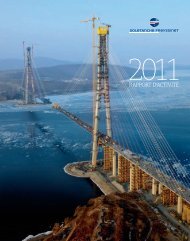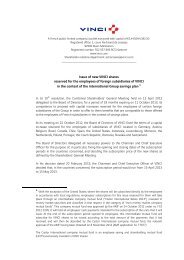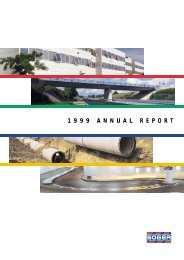VINCI - 2005 annual report
VINCI - 2005 annual report
VINCI - 2005 annual report
You also want an ePaper? Increase the reach of your titles
YUMPU automatically turns print PDFs into web optimized ePapers that Google loves.
Provisions for completion losses on contracts and construction project<br />
liabilities are made mainly when end-of-contract projections, based on<br />
the most likely estimated outcome, indicate a loss, and when work needs<br />
to be carried out in respect of completed projects under completion<br />
warranties.<br />
Provisions for disputes connected with operations mainly relate to<br />
disputes with customers, sub-contractors, joint contractors or suppliers.<br />
Restructuring provisions include the cost of plans and measures for which<br />
there is a commitment whenever these have been announced before the<br />
year end.<br />
Provisions for other current liabilities mainly comprise provisions for late<br />
delivery penalties, for individual dismissals and for other risks related to<br />
operations.<br />
Non-current provisions<br />
Non-current provisions are provisions not directly linked to the operating<br />
cycle and that are generally likely to reverse in more than one year.<br />
They include in particular provisions for disputes.<br />
Provisions for major repairs are made in respect of contractual obligations<br />
to return assets operated under concessions to good condition. These are<br />
calculated at the end of each period on the basis of a work programme<br />
covering several years which is reviewed <strong>annual</strong>ly to take account of planned<br />
expenditure.<br />
That part of non-current provisions that matures within less than one year<br />
is shown under current provisions.<br />
Financial debt (current and non-current)<br />
Financial debt comprises bonds and other loans and is recognised at<br />
amortised cost using the effective interest rate method. Under this method,<br />
the redemption premiums and issuance costs, shown as a deduction from<br />
the nominal amount of the liability, are included in the cost of borrowing.<br />
Under this method, the interest expense is recognised actuarially under<br />
the cost of gross financial debt.<br />
This heading also includes the debt component of the OCEANE bonds.<br />
An OCEANE bond is a hybrid instrument that includes a “debt” component<br />
and an “equity” component that corresponds to the option for<br />
conversion into a set number of <strong>VINCI</strong> shares granted to the holder.<br />
In accordance with IAS 32, the issue price of the hybrid instrument is<br />
apportioned between its debt component and its equity component, the<br />
equity component being defined as the difference between the issue price<br />
and the debt component. The debt component corresponds to the fair<br />
value of a debt having the same features but without the conversion option<br />
plus the fair value of issuers’ calls and investors’ puts, if any. The value<br />
attributed to the conversion option is not altered during the term of the<br />
loan. The debt component is measured using the amortised cost method<br />
over its estimated term. Issuance costs are allocated proportionately<br />
between the debt and equity components.<br />
204<br />
<strong>VINCI</strong> <strong>2005</strong> ANNUAL REPORT<br />
The part at less than one year of borrowings is included in current<br />
borrowings.<br />
Fair value of derivative financial instruments<br />
(assets and liabilities)<br />
The Group uses derivative financial instruments to hedge its exposure<br />
to market risks (interest rates, exchange rates, equity prices). Most interest<br />
rate and exchange rate derivatives used by <strong>VINCI</strong> may be considered as<br />
hedging instruments. Recognition as a hedging instrument is applicable if:<br />
– the hedging relationship is clearly defined and documented at the date<br />
when it is set up;<br />
– the effectiveness of the hedging relationship is demonstrated from the<br />
outset, and regularly while it is in place.<br />
Financial instruments considered as hedging instruments<br />
Derivative financial instruments considered as hedging instruments are<br />
systematically recognised in the balance sheet at fair value. Nevertheless,<br />
their recognition varies depending on whether they are considered as:<br />
– a fair value hedge of an asset or liability or of a firm commitment to buy<br />
or sell an asset;<br />
– a cash flow hedge; or<br />
– a hedge of a net investment in a foreign entity.<br />
– Fair value hedge<br />
A fair value hedge enables the exposure to the risk of a change in the fair<br />
value of an asset, a liability such as fixed rate loans and borrowings, assets<br />
and liabilities denominated in foreign currency or firm commitments not<br />
recognised, to be hedged.<br />
Changes in the fair value of the hedging instrument are recognised in<br />
profit or loss for the period. The impact of the revaluation of the hedged<br />
item is recognised symmetrically in profit or loss for the period. Except<br />
for the ineffective part of the hedge, these two revaluations offset each<br />
other within the same line items in the income statement.<br />
– Cash flow hedge<br />
A cash flow hedge allows the exposure to variability in future cash flows<br />
associated with a recognised asset or liability, or a highly probable forecast<br />
transaction, to be hedged.<br />
Changes in the fair value of the derivative financial instrument are recognised<br />
net of tax under equity for the effective part and in profit or loss for<br />
the period for the ineffective part. Cumulative gains or losses in equity<br />
must be reclassified in profit or loss under the same line item as the hedged<br />
item – i.e. under operating income and expenses for cash flows from<br />
operations and under financial income and expense otherwise - whenever<br />
the hedged cash flow affects profit or loss.<br />
If the hedging relationship is interrupted, in particular because it is no<br />
longer considered effective, the cumulative gains or losses in respect of<br />
the derivative instrument are retained in equity and recognised symmetrically<br />
with the cash flow hedged. If the future cash flow is no longer<br />
highly probable, the gains and losses previously recognised in equity are<br />
immediately taken to profit or loss.
















